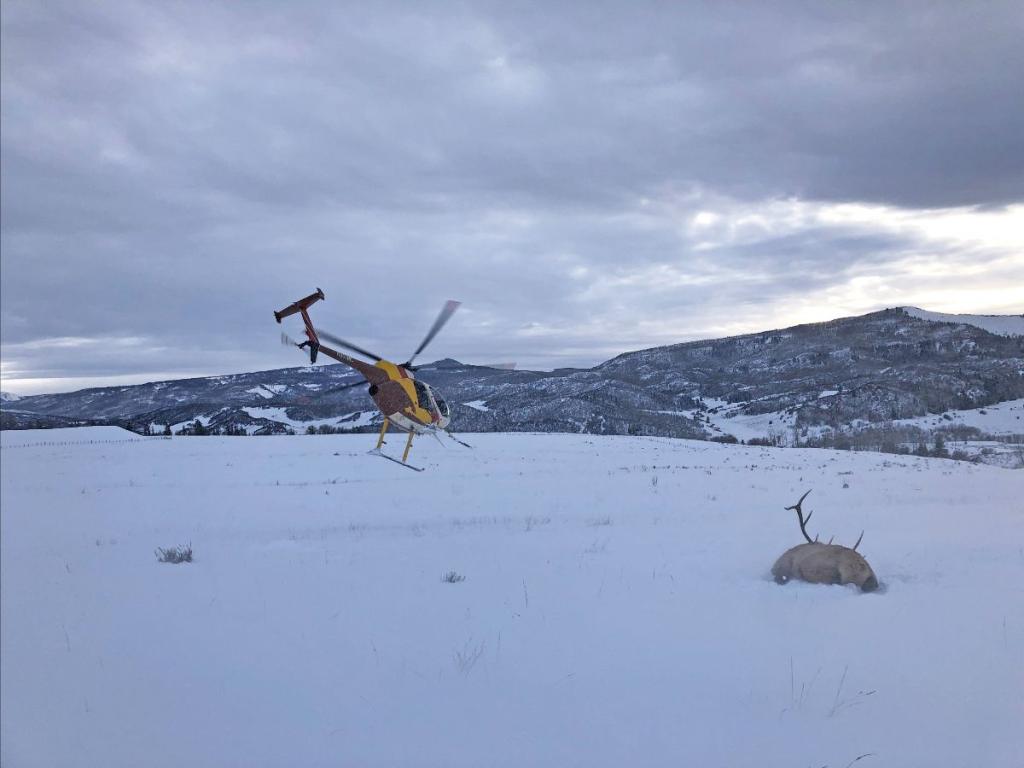CPW utilizing helicopters across Western Slope for critical wildlife work

 John Livingston
John LivingstonSouthwest Region Public Information Officer
970-759-9590 / [email protected]
@CPW_SW

CPW will work to place GPS collars on 75 elk calves in December, and research crews will also collar 120 pregnant cow elk during the month of March. This work will be conducted across the Bear’s Ears herd in northwest Colorado, the Avalanche Creek herd in the Roaring Fork Valley and the Uncompahgre herd west of Montrose.
Elk calves are captured using net guns and are quickly collared and released by the helicopter crew at the capture site. Pregnant elk involved in the study are transported by the helicopter crew a very short distance to a processing area where they are given a GPS collar and an implant that allows CPW researchers to track the pregnancy and calf survival. A veterinarian is also on site to assess the health of the animals.
Research work is conducted early in the gestation period when there will be no effect on the cow or calf. CPW aims to understand calf survival and cause-specific mortality across different study areas in the state.
“The data we collect from these efforts is critical to help us proactively manage elk populations in the state,” said CPW Wildlife Researcher Nathaniel Rayl. “In general, it is beneficial to conduct capture work in winter because the lower temperatures and snowfall provide better conditions for this work. Elk, moose, deer and pronghorn prefer cooler temperatures and are actually less stressed than if we were to capture in the summer when they may overheat and die. The deeper snow cushions the animal and helps prevent injuries, and they don't run as far, making capture easier and quicker. Conducting this work in the winter also allows us to gather critical information about pregnancy and body condition.”
Classification flights for big-game species such as deer, elk and bighorn sheep will also begin in December and be carried out through the winter as flying conditions permit. This work is done across the entire state.
Classification flights allow CPW to accurately estimate populations, recruitment of young animals into the population and sex ratios. Survey flights have a minimal impact on the wildlife, causing a disturbance that lasts only a few minutes. These flights will begin in early December and could extend into February.
“The classification flights will be critical to help us understand how last winter's weather conditions may have affected birth rates and survival of elk calves and fawns last summer,” said CPW Northwest Region Senior Wildlife Biologist Brad Banulis. “This is a critical data point to help us manage big game populations in the state, and we collect it in a manner that minimizes the stress on animals. We collect this data to manage robust and healthy wildlife populations, so we are always looking out for animal welfare and would not be doing capture or classification flights if we thought it was detrimental to the animals.”
In the Southwest Region, CPW will also radio collar 30 doe mule deer in Game Management Units 74 and 741 in La Plata County and parts of San Juan County. This work is scheduled to be conducted Dec. 20, depending on weather conditions.
Additionally, CPW is increasing its monitoring on the Western Slope and will place additional collars on deer and elk in the areas outside of Gunnison, Montrose, Meeker and Kremmling.
“Collecting survival rates and understanding cause-specific mortality is essential work for our wildlife biologists,” said CPW Senior Wildlife Biologist Jamin Grigg. “This work benefits multiple ongoing studies. We appreciate the public’s understanding of why they may be seeing helicopters throughout the state. If you see a low-level helicopter surveying wildlife, know that it’s CPW biologists out surveying the herds and getting out these important radio collars or tracking changes to our wildlife populations.”
BOTTOM RIGHT: A herd of elk are spotted from a helicopter during a CPW classification flight.


Colorado Parks and Wildlife (CPW) is an enterprise agency, relying primarily on license sales, state parks fees and registration fees to support its operations, including: 43 state parks and more than 350 wildlife areas covering approximately 900,000 acres, management of fishing and hunting, wildlife watching, camping, motorized and non-motorized trails, boating and outdoor education. CPW's work contributes approximately $6 billion in total economic impact annually throughout Colorado.
DISCLAIMER: The Colorado Parks and Wildlife (CPW) website maintains press releases containing historical information that may no longer be accurate. Press releases are dated, which should be noted to determine whether the information provided is current. Please review our current regulations and brochures for up-to-date information.